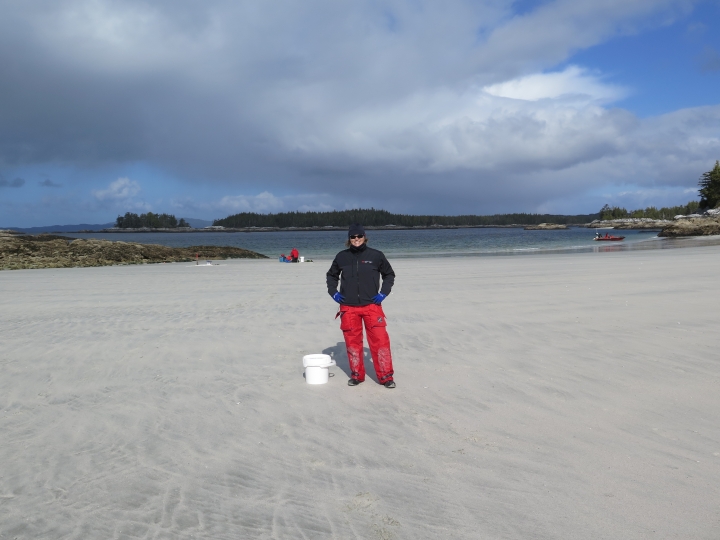Spotlight on science: Shoring up expertise - Sonia Laforest
Profile of Sonia Laforest
Shoring up expertise

Sonia Laforest has been a shoreline treatment expert with Environment and Climate Change Canada for over 20 years. While part of the National Environmental Emergencies Centre, she travelled across the country and the world responding to oil spills. For the last 10 years, she has been with the Emergencies Science and Technology Section and is now building a Shoreline Unit, sharing knowledge to protect Canada’s shorelines for years to come.
Responding to spills and developing expertise
Sonia grew up on shorelines and knew that was where she wanted to focus her work. She joined the National Environmental Emergencies Centre as a first responder, after finishing a master’s in physical geography with a specialization in fluvial environments (flood plains) from the Université de Sherbrooke in Quebec, working to oversee the cleanup of shorelines after spills.

Her work with the National Environmental Emergencies Centre was demanding and important, calling on her to respond to spills wherever, and whenever, they occurred.
“Shoreline treatment experts are among the first to go see the spill, evaluating it and its impact,” she says of her work. “And we also are the last ones to leave the site of the spill, because we have to evaluate if the environment is returning to what it was before.”
The process for responding to a spill that could affect a shoreline begins with reconnaissance, or surveying. “We call it the Shoreline Clean-Up Assessment Technique, or SCAT,” Sonia explains.
SCAT is a method of systematically assessing and documenting shorelines and riverbanks after a spill. This can include flying along the shoreline in a helicopter to see how much of the area is impacted and what types of habitats are affected, as well as doing beach-level analysis to determine the type of shoreline and substrate. All of this information helps shape the strategy for cleaning up the spill.
Working at the National Environmental Emergencies Centre office in Quebec, Sonia developed a deep knowledge of the province’s shorelines, rivers, and bays. Her work also took her across Canada and even to South Korea and Tunisia to support international responses to spills.
“You feel you are doing something significant for the environment, because if it’s not cleaned up, the oil can stay there forever.”
Building a team
In 2013, Sonia moved from the National Environmental Emergencies Centre to the Emergencies Science and Technology Section, where she is now head of a growing shoreline unit that provides expertise on shoreline decontamination to the National Environmental Emergencies Centre. The growth of the unit, made possible through the second phase of the Oceans Protection Plan, means more resources are available to protect Canada’s thousands of kilometres of shoreline and to conduct research into new types of oil.
What is the Oceans Protection Plan?
The Oceans Protection Plan is a series of Government of Canada initiatives that aim to protect Canada’s marine ecosystems and wildlife. Under the Oceans Protection Plan, Environment and Climate Change Canada is working to improve how we prepare for, and respond to, pollution emergencies.
This includes gathering important information about shorelines through shoreline surveys—measuring the slope of a shoreline, taking photos, digging test pits, and taking sediment samples. The information is documented in a Pre-Shoreline Clean-Up Assessment Technique (Pre-SCAT) form and provides important, up-to-date information should a spill ever impact the area.
One developing project that Sonia is excited about is setting up test “beaches” with different types of sediment in Environment and Climate Change Canada labs, to see what happens when different oils are added—how far the oil penetrates the sediment, how much is retained, and how various elements, including wind, sun, and tide, affect how everything behaves.
“I’m looking forward to working with my team to get a better understanding of how newer oils behave in different environments,” says Sonia.
Learning from others and sharing knowledge

Sonia’s work on shorelines has given her two main takeaways: no two shorelines are the same, and the people who live along a shoreline will understand it more than any expert.
She also highlights the importance of mentors: “People who you will follow and say, they are doing great things for the environment.”
She looks back at the work done in the ‘80s and ‘90s, including the tremendous amount of research and the methodologies that were developed after large spills in the late ‘80s, reflecting that many of those experts have since retired. “If I’m building a team, I’m going to share the expertise and what we’ve learned since the ‘70s.”
Leading a team is a shift for Sonia, who never imagined herself in that role, having spent the early part of her career as the sole shoreline expert on a spill site.
“It’s like, for a while you do something and it’s just normal, but now I’m in more of a position to pass on the knowledge.” She adds, “I feel so old when I say that. But it’s OK—we all reach the point in our career when it’s time to pass on the knowledge. That’s what I’m most proud of.”